 |
Kage Studio 0.7.230428
A Simple Free and Open Source 2D Animation Software
|
 |
Kage Studio 0.7.230428
A Simple Free and Open Source 2D Animation Software
|
#include <frameset.h>
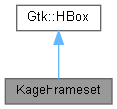
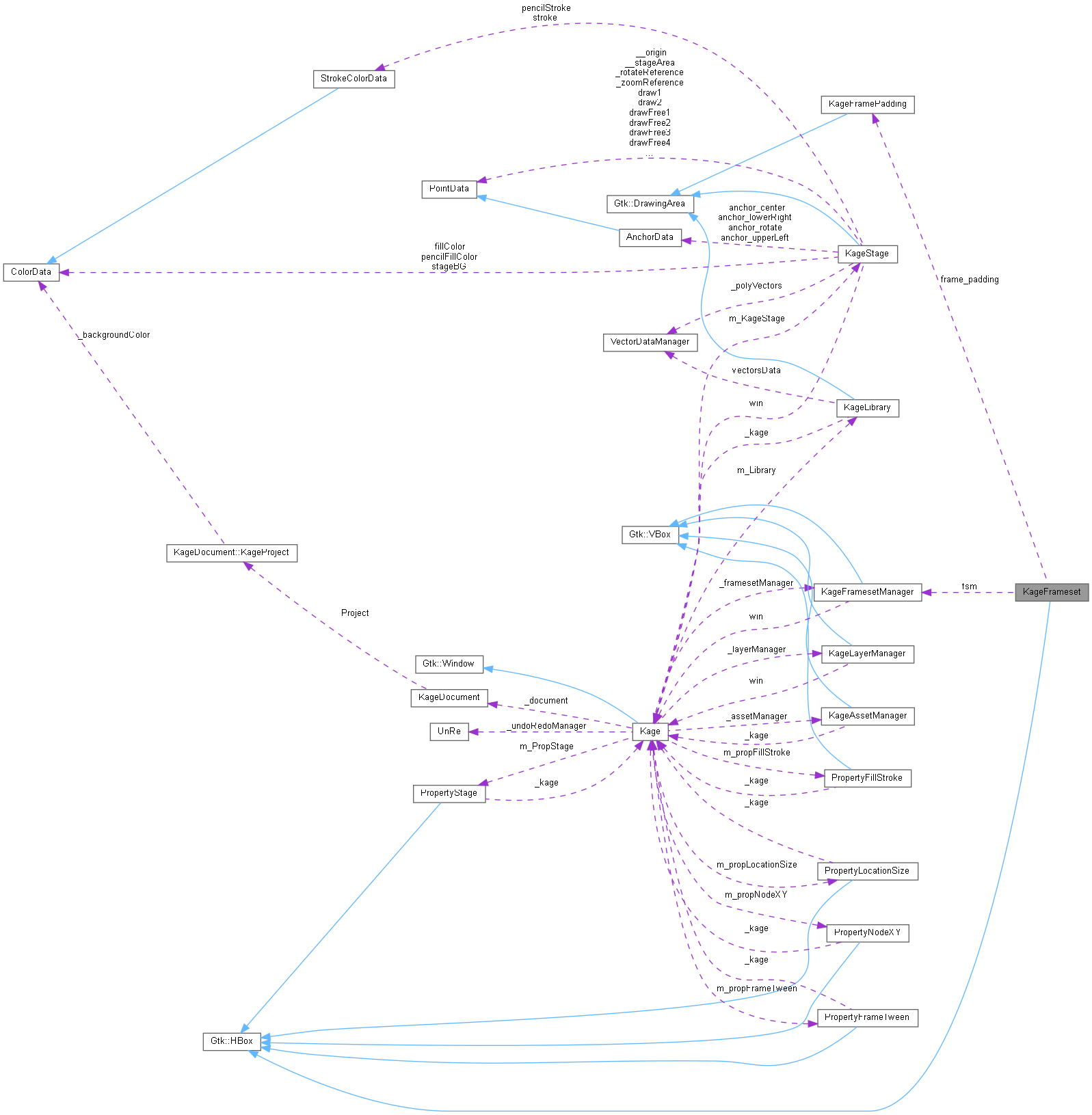
Public Member Functions | |
| KageFrameset (KageFramesetManager *p_fsm, unsigned int p_layerID, unsigned int p_frameCount) | |
| virtual | ~KageFrameset () |
| unsigned int | getID () |
| bool | selectAll (bool p_selectAll) |
| unsigned int | getFrameCount () |
| bool | addFrame () |
| void | duplicateFrame () |
| void | extendFrame () |
| bool | removeFrame () |
| unsigned int | getCurrentFrame () |
| void | setCurrentFrame (unsigned int p_frame) |
| void | setCurrentFrameByID (unsigned int p_frameID) |
| void | focusFrame (unsigned int p_frame) |
| void | removeAllFrames () |
| KageFramesetManager * | getFsm () |
| KageFrame * | getFrameAt (unsigned int p_frame) |
| unsigned int | getFrameNumberByID (unsigned int p_frameID) |
| void | setSelected (KageFrame *p_frame) |
| vector< unsigned int > | raiseSelectedShape (vector< unsigned int > p_selectedShapes) |
| vector< unsigned int > | lowerSelectedShape (vector< unsigned int > p_selectedShapes) |
| vector< unsigned int > | raiseToTopSelectedShape (vector< unsigned int > p_selectedShapes) |
| vector< unsigned int > | lowerToBottomSelectedShape (vector< unsigned int > p_selectedShapes) |
| vector< unsigned int > | groupSelectedShapes (vector< unsigned int > p_selectedShapes) |
| vector< unsigned int > | ungroupSelectedShapes (vector< unsigned int > p_selectedShapes) |
| vector< unsigned int > | duplicateShapes (vector< unsigned int > p_selectedShapes) |
| bool | flipHorizontalSelectedShape (vector< unsigned int > p_selectedShapes) |
| bool | flipVerticalSelectedShape (vector< unsigned int > p_selectedShapes) |
| bool | doFlipVerticalSelectedShapeOn (unsigned int p_frameIndex, vector< unsigned int > p_selectedShapes) |
| bool | doFlipVerticalSelectedShapeOnExtendedFrame (unsigned int p_frameIndex, vector< unsigned int > p_selectedShapes) |
| bool | recenterRotationPoint (vector< unsigned int > p_selectedShapes) |
| bool | addDataToFrame (VectorDataManager p_vectorsData) |
| bool | setFrameData (VectorDataManager p_vectorsData) |
| VectorDataManager | getFrameTweenData (unsigned int p_frameIndex) |
| VectorDataManager | getFrameData () |
| VectorDataManager | getFrameDataAt (unsigned int p_frame) |
| VectorDataManager | getPreviousFrameData (unsigned int p_frameID) |
| NOTE: "Frame" – NOT "frame ID". | |
| bool | setFrameDataToPreviousFrame (VectorDataManager p_vectorsData, unsigned int p_frameID) |
| Called by KageFrame if KageFrame is Extended. | |
| bool | addDataToPreviousFrame (VectorDataManager v, unsigned int p_frameID) |
| Called by KageFrame if KageFrame is Extended. | |
| bool | setPreviousFrameTween (unsigned int p_frameID, unsigned int p_tween) |
| Called by KageFrame if KageFrame is Extended. | |
| bool | setExtendedFrameTween (unsigned int p_frameID, unsigned int p_tween) |
| bool | forceSetTween (unsigned int p_tween) |
| bool | setTween (unsigned int p_tween) |
| unsigned int | getTween () |
| bool | switchToPreviousFrame () |
| bool | switchToPreviousFrame (unsigned int p_frameID) |
| Called by FrameSet for navigating to Previous Frame. | |
| bool | switchToNextFrame () |
| Called by KageFrame for navigating to Previous Frame. | |
| bool | switchToNextFrame (unsigned int p_frameID) |
| Called by FrameSet for navigating to Next Frame. | |
| bool | isCurrentFrame (unsigned int p_frameID) |
| Called by KageFrame for navigating to Next Frame. | |
| bool | canReUseNextFrame () |
| Called by KageFrame when rendering. | |
| void | setFrameExtension (KageFrame::extension p_extension) |
| Called by KageFramesetManager when duplicating Frame. | |
Protected Member Functions | |
| bool | moveToLeft () |
| bool | moveToLeftAt (unsigned int p_frame) |
| Moves Current Frame to Left. | |
| bool | moveToLeftMost () |
| Moves Current Frame to Left on indicated Frame. | |
Protected Attributes | |
| unsigned int | layerID |
| unsigned int | frameCtr |
| std::vector< KageFrame * > | _frames |
| KageFramePadding | frame_padding |
| KageFramesetManager * | fsm |
| unsigned int | _currentFrameID |
| unsigned int | _currentFrameIndex |
| KageFrameset::KageFrameset | ( | KageFramesetManager * | p_fsm, |
| unsigned int | p_layerID, | ||
| unsigned int | p_frameCount | ||
| ) |

|
virtual |
| bool KageFrameset::addDataToFrame | ( | VectorDataManager | p_vectorsData | ) |

| bool KageFrameset::addDataToPreviousFrame | ( | VectorDataManager | v, |
| unsigned int | p_frameID | ||
| ) |
| bool KageFrameset::addFrame | ( | ) |


| bool KageFrameset::canReUseNextFrame | ( | ) |
Called by KageFrame when rendering.
| bool KageFrameset::doFlipVerticalSelectedShapeOn | ( | unsigned int | p_frameIndex, |
| vector< unsigned int > | p_selectedShapes | ||
| ) |


| bool KageFrameset::doFlipVerticalSelectedShapeOnExtendedFrame | ( | unsigned int | p_frameIndex, |
| vector< unsigned int > | p_selectedShapes | ||
| ) |

| void KageFrameset::duplicateFrame | ( | ) |
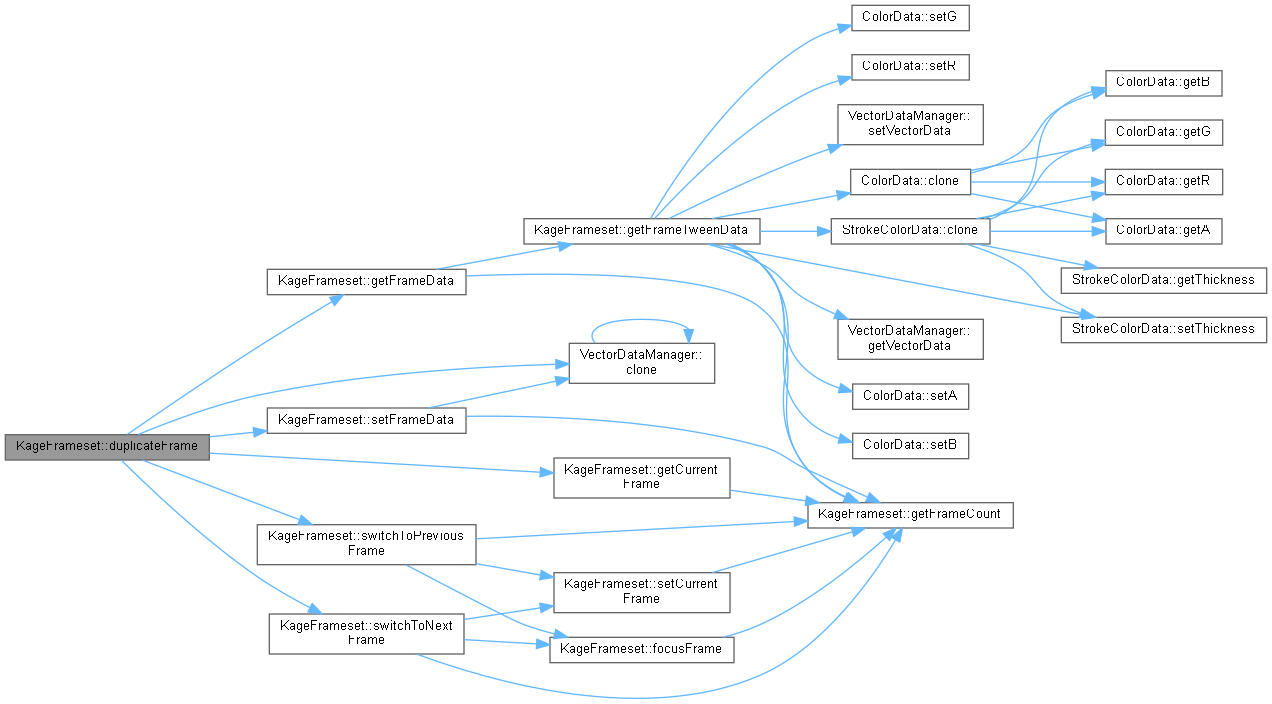
| vector< unsigned int > KageFrameset::duplicateShapes | ( | vector< unsigned int > | p_selectedShapes | ) |

| void KageFrameset::extendFrame | ( | ) |

| bool KageFrameset::flipHorizontalSelectedShape | ( | vector< unsigned int > | p_selectedShapes | ) |

| bool KageFrameset::flipVerticalSelectedShape | ( | vector< unsigned int > | p_selectedShapes | ) |

| void KageFrameset::focusFrame | ( | unsigned int | p_frame | ) |


| bool KageFrameset::forceSetTween | ( | unsigned int | p_tween | ) |

| unsigned int KageFrameset::getCurrentFrame | ( | ) |


| KageFrame * KageFrameset::getFrameAt | ( | unsigned int | p_frame | ) |


| unsigned int KageFrameset::getFrameCount | ( | ) |
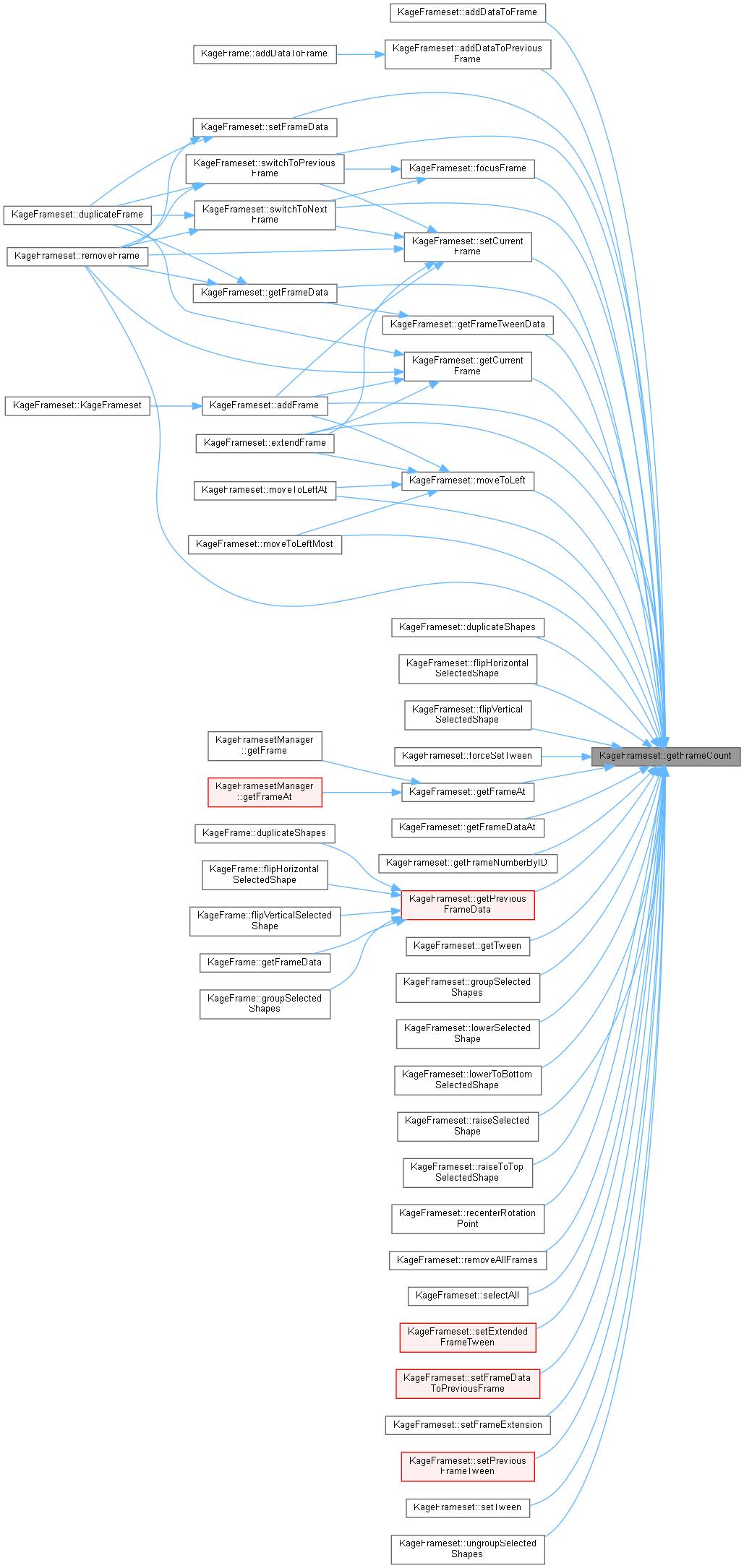
| VectorDataManager KageFrameset::getFrameData | ( | ) |
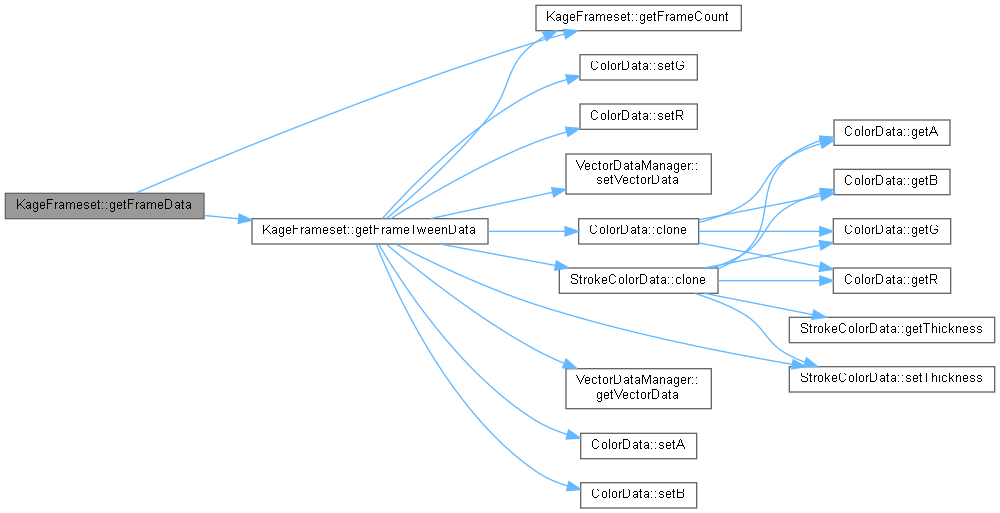

| VectorDataManager KageFrameset::getFrameDataAt | ( | unsigned int | p_frame | ) |

| unsigned int KageFrameset::getFrameNumberByID | ( | unsigned int | p_frameID | ) |

| VectorDataManager KageFrameset::getFrameTweenData | ( | unsigned int | p_frameIndex | ) |
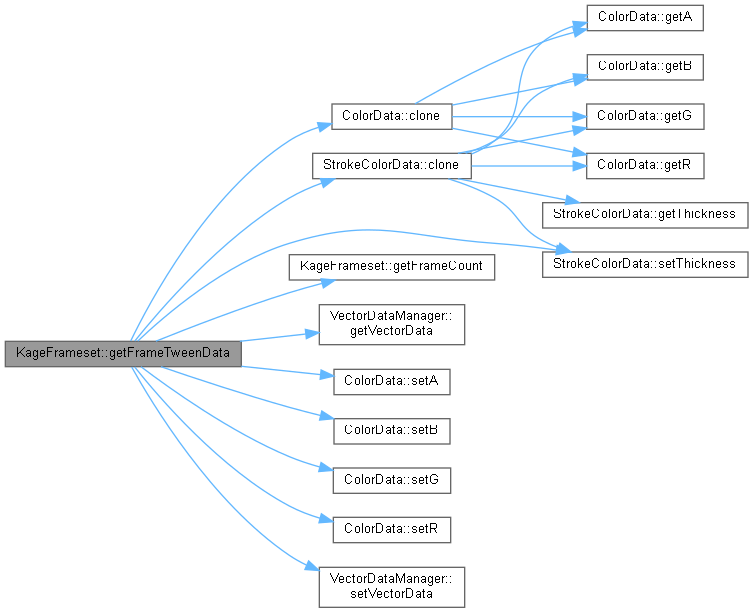

| KageFramesetManager * KageFrameset::getFsm | ( | ) |

| unsigned int KageFrameset::getID | ( | ) |
| VectorDataManager KageFrameset::getPreviousFrameData | ( | unsigned int | p_frameID | ) |
NOTE: "Frame" – NOT "frame ID".

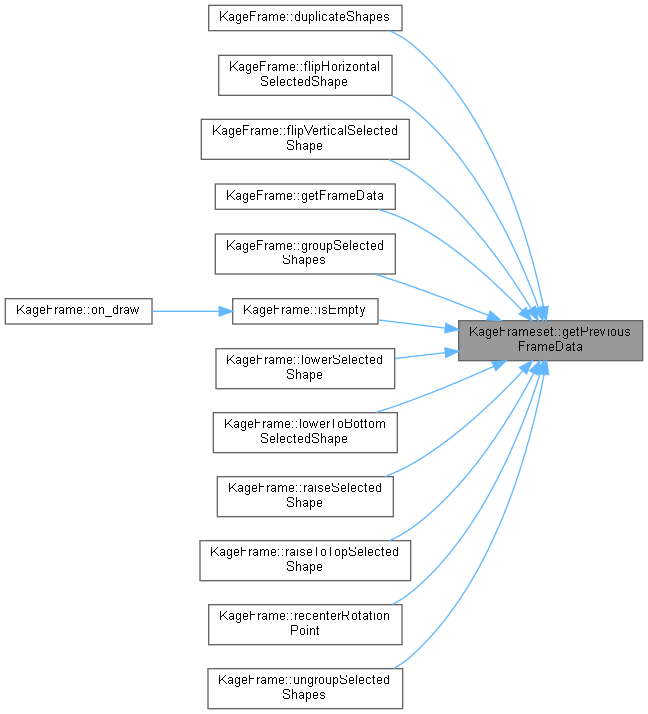
| unsigned int KageFrameset::getTween | ( | ) |

| vector< unsigned int > KageFrameset::groupSelectedShapes | ( | vector< unsigned int > | p_selectedShapes | ) |

| bool KageFrameset::isCurrentFrame | ( | unsigned int | p_frameID | ) |
| vector< unsigned int > KageFrameset::lowerSelectedShape | ( | vector< unsigned int > | p_selectedShapes | ) |

| vector< unsigned int > KageFrameset::lowerToBottomSelectedShape | ( | vector< unsigned int > | p_selectedShapes | ) |

|
protected |


|
protected |
Moves Current Frame to Left.

|
protected |
Moves Current Frame to Left on indicated Frame.

| vector< unsigned int > KageFrameset::raiseSelectedShape | ( | vector< unsigned int > | p_selectedShapes | ) |

| vector< unsigned int > KageFrameset::raiseToTopSelectedShape | ( | vector< unsigned int > | p_selectedShapes | ) |

| bool KageFrameset::recenterRotationPoint | ( | vector< unsigned int > | p_selectedShapes | ) |

| void KageFrameset::removeAllFrames | ( | ) |

| bool KageFrameset::removeFrame | ( | ) |
If KageFrame is NULL or Last Frame (but not Frame-index0), remove Frame Widget, else, do below steps.
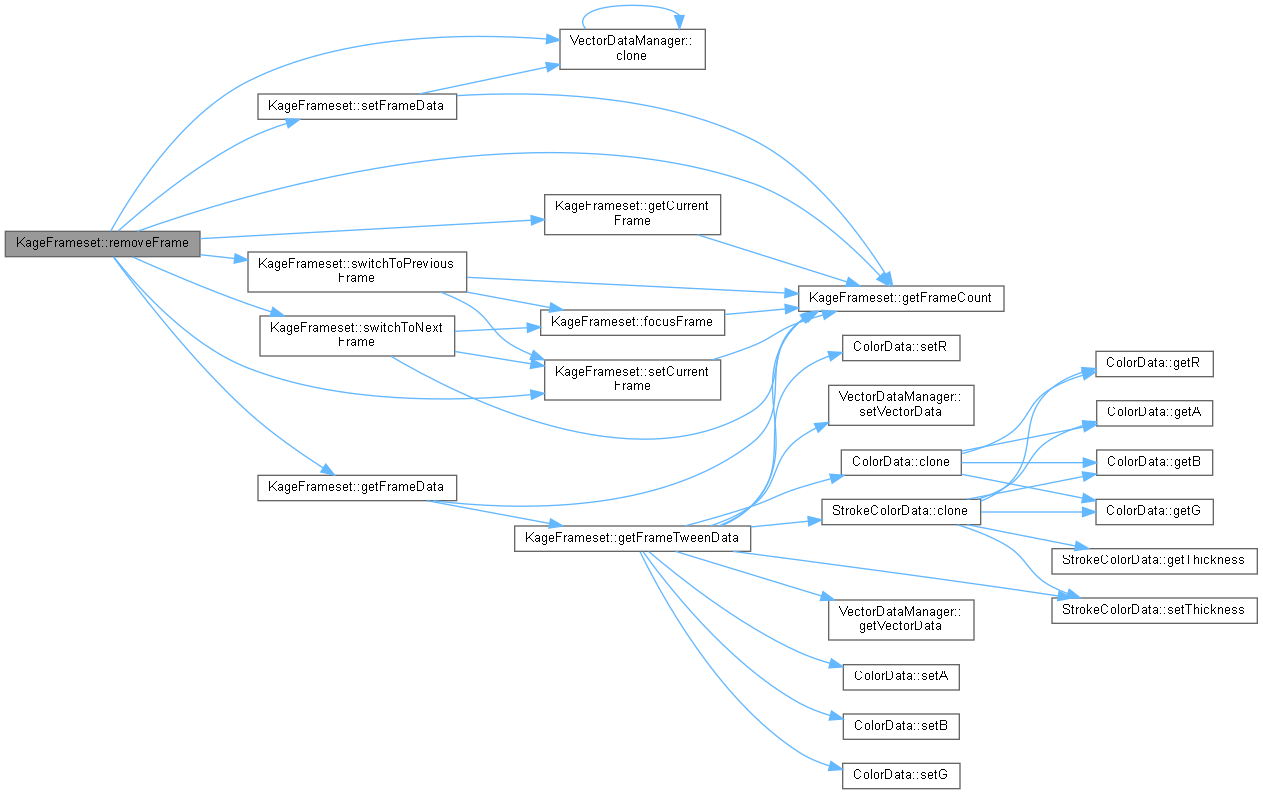
| bool KageFrameset::selectAll | ( | bool | p_selectAll | ) |

| void KageFrameset::setCurrentFrame | ( | unsigned int | p_frame | ) |
For use of Kage. When a KageLayer is clicked, KageLayerManager will call this function via Kage then sets currently active Frame along Layer
| p_frame | is Frame Number known to KageFrame(/Layer?) |

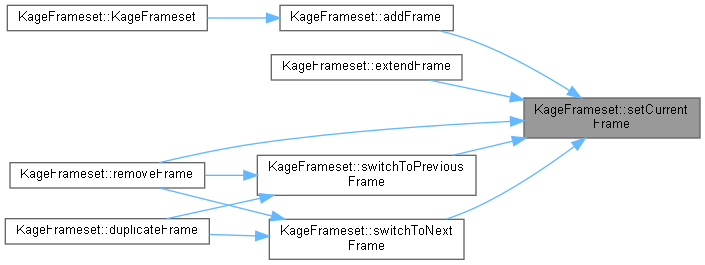
| void KageFrameset::setCurrentFrameByID | ( | unsigned int | p_frameID | ) |
| bool KageFrameset::setExtendedFrameTween | ( | unsigned int | p_frameID, |
| unsigned int | p_tween | ||
| ) |


| bool KageFrameset::setFrameData | ( | VectorDataManager | p_vectorsData | ) |


| bool KageFrameset::setFrameDataToPreviousFrame | ( | VectorDataManager | p_vectorsData, |
| unsigned int | p_frameID | ||
| ) |
| void KageFrameset::setFrameExtension | ( | KageFrame::extension | p_extension | ) |
Called by KageFramesetManager when duplicating Frame.
For use of Kage when loading KSF file
| p_extension | if start/mid/end of frame extension |

| bool KageFrameset::setPreviousFrameTween | ( | unsigned int | p_frameID, |
| unsigned int | p_tween | ||
| ) |
| void KageFrameset::setSelected | ( | KageFrame * | p_frame | ) |
| bool KageFrameset::setTween | ( | unsigned int | p_tween | ) |

| bool KageFrameset::switchToNextFrame | ( | ) |
Called by KageFrame for navigating to Previous Frame.
index + 1 = becomes frameNumber for current. then +1 becomes frameNumber of Next Frame


| bool KageFrameset::switchToNextFrame | ( | unsigned int | p_frameID | ) |
Called by FrameSet for navigating to Next Frame.
index + 1 = becomes frameNumber for current. then +1 becomes frameNumber of Next Frame

| bool KageFrameset::switchToPreviousFrame | ( | ) |
index + 1 = becomes frameNumber for current. then -1 becomes frameNumber of Previous Frame; thus ‘setCurrentFrame(i)’


| bool KageFrameset::switchToPreviousFrame | ( | unsigned int | p_frameID | ) |
Called by FrameSet for navigating to Previous Frame.
index + 1 = becomes frameNumber for current. then -1 becomes frameNumber of Previous Frame; thus ‘setCurrentFrame(i)’

| vector< unsigned int > KageFrameset::ungroupSelectedShapes | ( | vector< unsigned int > | p_selectedShapes | ) |

|
protected |
|
protected |
|
protected |
|
protected |
|
protected |
|
protected |
|
protected |